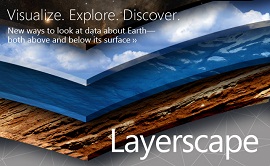Powered by WorldWide Telescope
 A cloud-based user experience, Layerscape employs powerful, everyday tools to analyze and visualize complex Earth and oceanic datasets—enabling scientists to gain environmental insights into Earth. Users can create and share 3-D virtual tours based on their discoveries and collaborate with the Earth-science community in ways that previously seemed impossible. Build your own virtual tours and experience the possibilities.
A cloud-based user experience, Layerscape employs powerful, everyday tools to analyze and visualize complex Earth and oceanic datasets—enabling scientists to gain environmental insights into Earth. Users can create and share 3-D virtual tours based on their discoveries and collaborate with the Earth-science community in ways that previously seemed impossible. Build your own virtual tours and experience the possibilities.
| Visualize | Explore | Discover |
| Large and complex data sets by using powerful, everyday tools | Large and complex data sets by using powerful, everyday tools | New insights through community collaboration that seemed impossible |
-
Features
WorldWide Telescope Layerscape Application
- WorldWide Telescope (WWT), in combination with the WWT Excel Add-in, makes it easy for you to bring your data into a powerful visualization engine.
- Layerscape helps transform your data into information by combining freedom of perspective with spatialhttps://www.microsoft.com/en-us/research/?post_type=msr-project&p=169859&lang=fr_ca&locale=zh-cnporal rendering and playback.
- The 3-D environment with transparency control enables you to visualize your data—whether it be on, below, or above the Earth’s surface.
- Time-series data support allows ephemeral data to appear and disappear as time elapses for more than 500,000 data points
- Layerscape supports point, vector, and raster data—including map overlays, well known text, shape files, Microsoft Excel spreadsheets, CSV, and more.
- Story-authoring tools allow you to create rich, interactive 3-D visualizations and narratives.
Cloud-Based Community
- Share data, visualizations, stories, and related files (such as images, shape files, and maps) with colleagues, friends, or the general public.
- Take advantage of existing communities (Astronomy, Oceanography, Climate, and more) and learn about the latest developments directly from WorldWide Telescope.
- Create your own community, based, for example, on your organization or area of research.
- Participate in discussions: ask questions; share hypotheses; even copy, edit, and re-publish content to reflect your own perspective, expertise, and ideas.
- Publish your own WorldWide Telescope visualizations, stories, data, and metadata.
- Credit your data sources as you publish and receive credit for your work with our evolving citation tools.
WorldWide Telescope Excel Add-in
- Import data into Layerscape’s WWT visualization environment and browse your Layerscape content and communities directly from WWT.
- When you manipulate your data in Excel, the add-in dynamically updates your layer in WWT.
- Take advantage of Excel’s powerful features, such as formulas.
- Capture viewpoints (like bookmarks) within the add-in and publish your file on Layerscape to share your data.
-
Using Layerscape
Layerscape consists of the following free elements:
- A powerful application for your PC.
- A cloud resource you can use for discovery and collaboration.
- A tool built on Microsoft Excel that makes it easy to manage your data.
Visit the Layerscape cloud resource and see how it enables you to visualize data and communicate data-driven stories in new ways.
-
-
-
Testimonials
“Layerscape offers the opportunity to look at a whole range of variables and overlay them in space and in time-so you can actually see how landscapes change and respond.”
—Mark Abbott, dean of the College of Earth, Ocean and Atmospheric Studies, Oregon State University
“The more rapidly we can share data, the faster can be the pace of scientific understanding and innovation. Layerscape begins to take this to a new level. Not just by sharing the data but potentially sharing the analysis experience.”
—Jim Bellingham, chief technologist, Monterey Bay Aquarium Research Institute
“When we saw the first demo, we realized we could input our Excel data for the past 150 years of seismic activity. Three minutes later, it was visualized with a timeline—and dazzled everybody here.”
—Lee Allison, state geologist of Arizona
